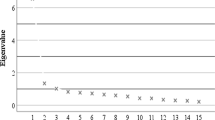Abstract
This study explores the ubiquitous links between human behavior and perception of first-generation green buildings in India. It is generally assumed that similar rated green buildings should invoke similar levels of user satisfaction. However, this remains significantly under-researched in case of India’s first-generation green buildings. The level of user experience and perception is studied through a five-point occupant questionnaire survey across three similar green-rated office buildings in India. The case study buildings are located in Delhi-NCR and lie in the same climatic zone. Twenty-five attributes related to user satisfaction are taken into consideration. The questionnaire responses are statistically analyzed using data reduction method of factor analysis to understand the latent variables that affect human experience. The results indicate that there is significant non-uniformity in the user experience and perception. The study suggests that human behavioral aspects should be considered in the design process as only physical attributes and environmental factors may not be sufficient to evaluate the performance of a green building. The broader aim of the study is to create higher acceptability of green buildings among the users that would enable across urban sectors.
Access this chapter
Tax calculation will be finalised at checkout
Purchases are for personal use only
Similar content being viewed by others
References
Z. Brown, R.J. Cole, J. Robinson, H. Dowlatabadi, Evaluating user experience in green buildings in relation to workplace culture and context. Facilities 28, 225–238 (2010)
Z. Gou, D. Prasad, S. Siu-Yu Lau, Are green buildings more satisfactory and comfortable? Habitat Int. 39, 156–161 (2013)
F. Xue, Z. Gou, S.S.Y. Lau, Human factors in green office building design: the impact of workplace green features on health perceptions in high-rise high-density asian cities. Sustain. 8 (2016)
A. Dearry, Impacts of our built environment on public health. Environ. Health Perspect. 112, 600–601 (2004)
R. Bardhan, R. Debnath, Towards daylight inclusive bye-law: daylight as an energy saving route for affordable housing in India. Energy. Sustain. Dev. 34, 1–9 (2016)
R. Debnath, R. Bardhan, Daylight performance of a naturally ventilated building as parameter for energy management. Energy Procedia. 90, 382–394 (2015)
R. Bardhan, K. Kurisu, K. Hanaki, Does compact urban forms relate to good quality of life in high density cities of India? Case of Kolkata. Cities. 48, 55–65 (2015)
R. Bardhan, H. Kurisu, Kiyo, K. Hanaki, Linking urban form & quality of life in Kolkata, India. ISOCARP Congr. 47, 1–12 (2011)
O.E. Mansour, S.K. Radford, Green building perception matrix, a theoretical framework. 16th Annu. Archit. Res. Symp. Finl. 40–52 (2014)
Å.L. Hauge, J. Thomsen, T. Berker, User evaluations of energy efficient buildings: literature review and further research. Zero Emiss. Build. - Proc. Renew. Energy Conf. 97–108 (2010)
L. Aye, W.W.S. Charters, M. Chiazor, J.R.W. Robinson, Evaluation of occupant perception and satisfaction in two new office buildings. Post Carbon World ANZSES 2005, 1–8 (2005)
Computing, R.A. language and environment for statistical computing. R.F. for S., Vienna, A.: R Core Team (2017), https://www.r-project.org/.%0A
O. David, Linear Regression (Springer, Carbondale, IL, 2015)
A. Wagner, E. Gossauer, C. Moosmann, T. Gropp, R. Leonhart, Thermal comfort and workplace occupant satisfaction-results of field studies in German low energy office buildings. Energy Build. 39, 758–769 (2007)
Author information
Authors and Affiliations
Corresponding author
Editor information
Editors and Affiliations
Rights and permissions
Copyright information
© 2020 Springer Nature Singapore Pte Ltd.
About this paper
Cite this paper
Malik, J., Bardhan, R. (2020). User Experience and Perception in First-Generation Green-Rated Office Buildings in India. In: Singh, S., Ramadesigan, V. (eds) Advances in Energy Research, Vol. 1. Springer Proceedings in Energy. Springer, Singapore. https://doi.org/10.1007/978-981-15-2666-4_51
Download citation
DOI: https://doi.org/10.1007/978-981-15-2666-4_51
Published:
Publisher Name: Springer, Singapore
Print ISBN: 978-981-15-2665-7
Online ISBN: 978-981-15-2666-4
eBook Packages: EnergyEnergy (R0)




